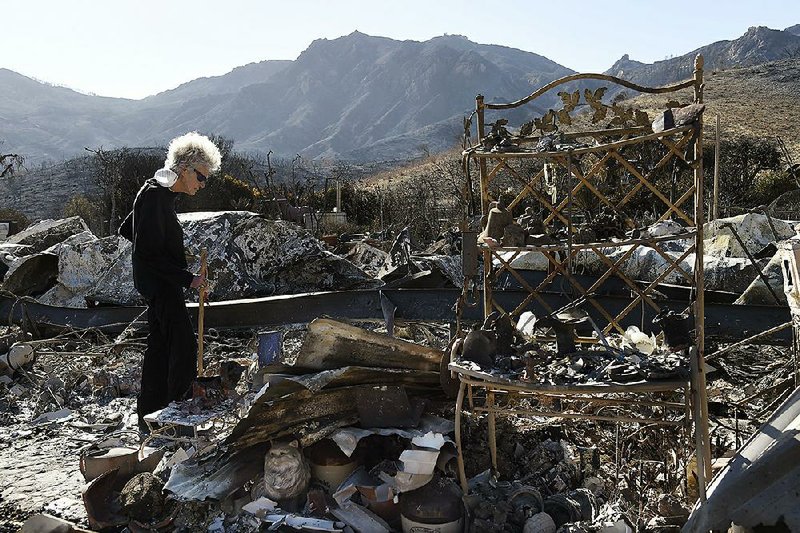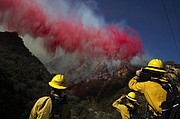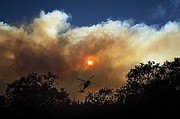PARADISE, Calif. -- As relatives desperately searched shelters for missing loved ones, crews stepped up the search for bodies in the smoking ruins of Paradise on Sunday, loading the remains of at least one victim into a hearse. Wildfires continued to rage on both ends of the state.
The statewide death toll stood at 31 and appeared certain to rise. At least 228 people were reported missing after the so-called Camp Fire ravaged a swath of Northern California.
At least five search teams were working in Paradise -- a town of 27,000 that was largely incinerated on Thursday -- and in surrounding communities. Authorities called in a mobile DNA lab and anthropologists to help identify victims of the most destructive wildfire in California history.
By early afternoon, one of the two black hearses stationed in Paradise had picked up another set of remains.
People looking for friends or relatives called evacuation centers, hospitals, police and the coroner's office.
Sol Bechtold drove from shelter to shelter looking for his mother, Joanne Caddy, a 75-year-old widow whose house burned down along with the rest of her neighborhood in Magalia, just north of Paradise. She lived alone and did not drive.
Bechtold posted a flyer on social media, pinned it to bulletin boards at shelters and showed her picture around to evacuees, asking if anyone recognized her. He ran across a few of Caddy's neighbors, but they hadn't seen her.
As he drove through the smoke and haze to yet another shelter, he said, "I'm also under a dark emotional cloud. Your mother's somewhere and you don't know where she's at. You don't know if she's safe."
He added: "I've got to stay positive. She's a strong, smart woman."
Officials and relatives held out hope that many of those unaccounted for were safe and simply had no cellphones or other ways to contact loved ones. The sheriff's office in the stricken northern county set up a missing-persons call center to help connect people.
Gov. Jerry Brown said California is requesting aid from President Donald Trump's administration. Trump has blamed "poor" forest management for the fires.
"With proper Forest Management, we can stop the devastation constantly going on in California. Get Smart!" Trump tweeted Sunday morning, echoing a criticism that he has frequently leveled at California officials and threatening to withhold federal money.
Brown told a news briefing that federal and state governments must do more forest management but said that's not the source of the problem.
"Managing all the forests in everywhere we can does not stop climate change," Brown said. "And those who deny that are definitely contributing to the tragedies that we're now witnessing, and will continue to witness in the coming years."
Brian K. Rice, president of the California Professional Firefighters association, chided Trump, calling his words "ill-informed, ill-timed and demeaning to those who are suffering as well as the men and women on the front lines."
As the argument intensified, state firefighters found their resources divided between a historic fire in the north and a pair of fires in the south.
More than 8,000 firefighters in all battled three large wildfires burning across nearly 400 square miles in Northern and Southern California, with out-of-state crews continuing to arrive and gusty, blowtorch winds starting up again.
The worst of the blazes was in Northern California, where the number of people killed in that fire alone, at least 29, matched it to the deadliest on record in the state. Two people were also found dead in a wildfire in Southern California, where flames tore through Malibu mansions and working-class Los Angeles suburbs alike.
The two severely burned bodies were discovered in a driveway in celebrity-studded Malibu, where residents forced from their homes included Lady Gaga, Kim Kardashian West and Martin Sheen. Actor Gerard Butler said on Instagram that his Malibu home was "half-gone," and a publicist for Camille Grammer Meyer said the Real Housewives of Beverly Hills star lost her home in the seaside enclave.
Authorities said the two bodies were found in a vehicle that had been in the path of the wildfire, though homicide investigators are still working that case and have not officially declared a cause of death.
Flames also besieged Thousand Oaks, the Southern California city in mourning over the massacre of 12 people in a shooting rampage at a bar Wednesday night.
Los Angeles County Fire Chief Daryl Osby stressed there were numerous hotspots and plenty of fuel that had not yet burned.
"We're concerned about the fire jumping out, coming behind us, burning a lot of the territory that has not burned," Osby said.
He said the footprint of the Woolsey Fire contains many unburned areas that are vulnerable to embers stoked by gusts that could reach 40 mph. The fierce winds, which may last for three days, could make drops from firefighting air tankers less effective.
And with the Woolsey Fire only 10 percent contained, it could roll south along the Pacific Coast, from Malibu to Topanga Canyon and on to Pacific Palisades, to the doorstep of Santa Monica.
"The only thing we're not concerned about is the ocean," Osby said.
Fire crews, including many from out of state, were deployed throughout areas projected to be in the path of furious Santa Ana winds. The goal is to stamp out any new fires before they expand rapidly, and to continue to try to contain the Woolsey Fire, which has burned more than 83,000 acres, destroyed at least 150 houses and created a huge mandatory evacuation zone in Ventura and Los Angeles counties. But fire officials working in steep terrain that's hard to reach say they are short of crews and equipment.
In Northern California, Butte County Sheriff Kory Honea said the county consulted anthropologists from California State University at Chico because, in some cases, investigators have been able to recover only bones and bone fragments.
The devastation was so complete in some neighborhoods that "it's very difficult to determine whether or not there may be human remains there," Honea said.
Authorities were also bringing in a DNA lab and encouraged people with missing relatives to submit samples to aid in identifying the dead after the blaze destroyed more than 6,700 buildings, nearly all of them homes.
Firefighters gained modest ground overnight against the blaze, which grew slightly to 170 square miles from the day before but was 25 percent contained, up from 20 percent, according to the state fire agency, Cal Fire.
But Cal Fire spokesman Bill Murphy warned that gusty winds predicted into this morning could spark "explosive fire behavior."
About 300,000 people statewide were under evacuation orders, most of them in Southern California.
Fire officials said Sunday morning that the larger of that region's two fires, the one that hit Malibu, grew to 130 square miles and was 10 percent contained. But the strong, dry Santa Ana winds that blow from the interior toward the coast returned after a one-day lull, fanning the flames.
The count of lost structures in both Southern California fires climbed to nearly 180, authorities said. The large mobile home community of Seminole Springs, in the rugged Santa Monica Mountains north of Malibu, appeared devastated.
"I smelled the fire and didn't think, grabbed my dog and left," Seminole Springs resident Lisa Kin said Sunday, tears in her eyes and her voice breaking. "It hasn't burned in decades and I knew we didn't stand a chance."
She described Seminole Springs as a "beautiful community" of families and older people who appreciate its tranquility. But she said she always feared a wildfire since she moved there 15 years ago, especially during recent years in which there's been almost no rain.
Brown's request for a major-disaster declaration from Trump would make victims eligible for crisis counseling, housing and unemployment help, and legal aid.
Drought, warmer weather attributed to climate change, and the building of homes deeper into forests have led to longer and more destructive wildfire seasons in California. While California officially emerged from a five-year drought last year, much of the northern two-thirds of the state is abnormally dry.
"Things are not the way they were 10 years ago. ... The rate of spread is exponentially more than it used to be," said Ventura County Fire Chief Mark Lorenzen, urging residents to evacuate rather than stay behind to try to defend their homes.
Information for this article was contributed by Gillian Flaccus, Paul Elias, Andrew Selsky, Janie Har, Daisy Nguyen, Don Thompson, Martha Mendoza, Christopher Webber, Andrew Dalton and John Antczak of The Associated Press; and by Cleve R. Wootson Jr. and Joel Achenbach of The Washington Post.
A Section on 11/12/2018


